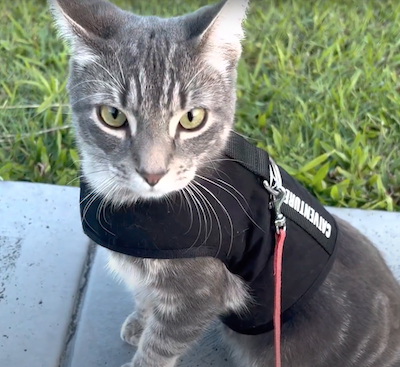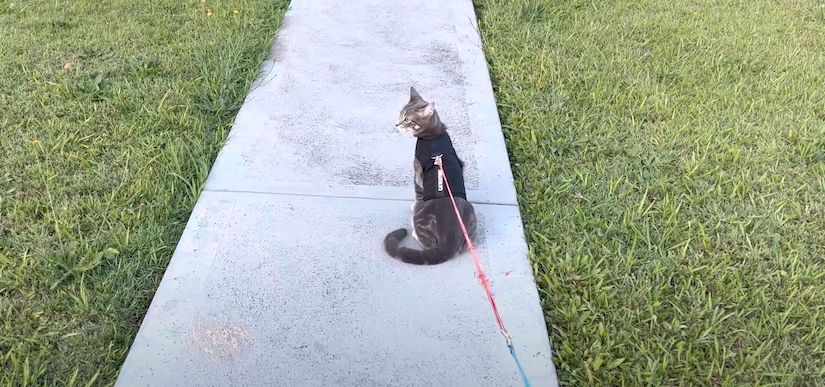Cats, known for their independent nature, have always been popular as pets that are easy to care for but rewarding. Over recent years, though, we’ve seen a rise in the amount of cat owners choosing to keep their cats indoors. As responsible cat owners, we understand the importance of providing our feline friends with both mental stimulation and physical exercise. One solution that’s gaining traction – which allows outdoor time but with significantly reduced dangers – is leash training.
In this article, we’ll explore the experience of leash training for cats, delving into when and why it might be necessary or beneficial, how to do it, potential dangers to be aware of, and the reasons behind keeping cats indoors.
Is leash training the right idea for my feline friend?
Why Consider Leash Training for Your Cat
Leash training isn’t just about giving your cat a taste of the great outdoors; it serves a multitude of purposes. Firstly, it provides essential exercise and mental stimulation, helping to combat obesity and boredom – common issues in indoor cats. Additionally, it allows cats to safely explore the outdoor world, sating their natural curiosity without exposing them to threats such as traffic or wildlife. (Provided your cat can’t escape from the leash)
Leash training might be helpful in various situations. For example, if you live in an apartment or a busy urban area, providing outdoor space for your cat to roam freely can be challenging. Leash training offers a solution by allowing your feline friend to get some fresh air while remaining safe. You can take them for a walk just like you would with a dog, (although they do not walk in a straight line) letting them spend time around nature, socialise, and take in the scents of the area.
For some, local wildlife can pose a threat to cats. Birds, rodents, or other small animals may provoke your cat’s hunting instincts, leading to conflicts with neighbours or wildlife conservation concerns. And not only can wildlife be a threat to cats, but vice versa. Particularly in countries where native animals are endangered, releasing cats outside with the ability to hunt creatures that aren’t evolved to protect themselves from felines can be lethal. This can have a snowball effect that impacts the entire environment. Leash training can help you manage these situations by providing controlled outdoor access.
Understanding Your Cat’s Behaviour
Before diving into leash training, it’s crucial to understand how cats typically react to new experiences. Cats are known for their cautious nature, and many can be initially sceptical about wearing a harness or leash. Signs of stress or anxiety may include hiding, hissing, growling, or attempting to wriggle out of the harness. They will usually act like they can no longer walk as if they have something very heavy on them. Or may roll around on the ground trying to get it off.
As with any form of training, a gradual approach is essential. You want your cat to associate the harness and leash with positive experiences. Offering treats and praise while they are in the harness can help build these positive associations.
How to Train Your Cat to Walk on a Leash: A Step-by-Step Guide
1. Choose the Right Harness:
Opt for a harness designed specifically for cats. Avoid using a leash attached to a collar, as it can be unsafe and uncomfortable for cats. They have sensitive necks, and don’t have the strength to be pulled from one spot in their body like a dog might. Collars can also slip off, and you don’t want to risk a runaway feline – especially if they’re already stressed by the collar, leash, and being outdoors.
2. Introduce the Harness Indoors:
Before you even think about going outside, let your cat get used to the harness indoors. Place the harness near your cat’s favourite resting spots, allowing them to sniff and investigate it at their own pace. Once your cat seems comfortable with the harness’s presence, gently place it on them for short periods. Offer treats and praise to create positive associations.
3. Gradually Increase Harness Time:
Over several days or weeks, gradually increase the amount of time your cat spends in the harness indoors. Engage in play or offer their favourite toys to distract them and make the experience enjoyable. This helps them get accustomed to moving in the harness, so when they go outside they can roam and play as normal.
4. Attach the Leash Indoors:
After your cat is comfortable with the harness, attach a lightweight leash to it indoors. Allow your cat to move around while supervised, ensuring they don’t get tangled or caught on anything. Offer treats and affection to reward your cat for wearing the harness and leash.
5. Practice Walking Indoors:
Encourage your cat to walk alongside you indoors using gentle tugs on the leash. Use treats or toys as incentives to keep them moving. Practice basic commands like “come” and “stay” indoors to establish communication between you and your cat while on the leash.
6. Choose the Right Time and Place for Outdoor Walks:
Pick a quiet, safe, and familiar outdoor location for your cat’s first venture outside. Avoid busy streets or areas with excessive noise and activity. If you have a small, enclosed garden area, patio, carport, etc., these can be safe places. You might even choose just the space by your front door so you’re near the cat’s familiar scents.
7. Keep Initial Walks Short:
During the first few outdoor walks, keep the sessions short to prevent overwhelming your cat. Gradually extend the duration as your cat becomes more comfortable.
8. Allow Exploration at Their Pace:
Let your cat explore their outdoor surroundings at their own pace. They may be cautious at first, so be patient and avoid pulling on the leash.
9. Use Positive Reinforcement:
Reward your cat with treats, praise, and affection when they exhibit good leash-walking behaviour. This positive reinforcement helps create a positive association with outdoor walks. This encourages the cat to have confidence and enjoy the experience.
10. Practice Consistency:
Regularity is key to successful leash training. Aim for daily walks, keeping a consistent schedule to reinforce the routine. Before dinner can be a great time, as they know they’ll have a big reward once they return home. Cats also like to be aware of their surroundings before eating, as an evolutionary defence, so they’ll enjoy getting to check the space near their home before settling in for dinner.
11. Be Attentive to Your Cat’s Signals:
Pay close attention to your cat’s body language during walks. If they show signs of stress, fear, or discomfort (e.g., flattened ears, dilated pupils, or attempts to hide), it’s essential to end the walk and return indoors. Creating negative associations with walks will hurt your chances of success.
12. Gradually Increase the Walk Radius:
As your cat becomes more confident, you can gradually expand the walking radius. Allow them to explore new areas while monitoring their reactions. However, remember that cats are territorial creatures that don’t need a lot of space, and can be upset when coming across other cats in their space. Be careful to only take your cat as far as they’re comfortable, and still within the radius of home.
13. Practice Safety:
Always prioritise your cat’s safety. Ensure the harness and leash are secure, and never leave your cat unattended during outdoor walks. Keep checking in with them to see how they’re feeling and reacting.
14. Enjoy the Journey:
Leash training is a journey that requires patience and understanding. Embrace each small success, and remember that it’s about enriching your cat’s life and strengthening the bond between you.
By following these steps and paying attention to your cat’s unique needs and reactions, you can successfully train your feline friend to walk on a leash, providing them with safe and enjoyable outdoor experiences.
See Storm one of our cats walking on a leash
Understanding Your Cat’s Reactions
While some cats don’t take to leash training with enthusiasm, others may display signs of excitement or curiosity. They might eagerly explore the outdoor world, pausing to investigate new scents or chase after leaves. These reactions are entirely normal and indicate that your cat is enjoying the experience.
On the flip side, some cats may react with fear or stress during outdoor walks. Signs of stress can include flattened ears, dilated pupils, excessive panting, or attempts to escape the harness. If your cat shows these signs, it’s essential to stop the walk and return indoors. Gradually reintroduce the harness and outdoor walks to help your cat acclimate over time.
Leash training can provide numerous benefits for both you and your feline friend. It offers a safe way for indoor cats to enjoy the outdoors, providing exercise and mental stimulation while minimising potential dangers. However, leash training requires patience and understanding of your cat’s unique personality and needs. By taking a gradual approach, monitoring your cat’s reactions, and prioritising their comfort and safety, you can make outdoor adventures a rewarding experience for both you and your beloved cat.

Are you looking to adopt a pet or donate to a pet rescue organisation? Georgie and Cindy from Large Hope SEO foster cats and kittens on the Sunshine Coast in Australia. If you’re local, get in touch to discuss adopting from the rescues. See cats and kittens available for adoption or donate so we can save more kittens.
 seolounge
seolounge